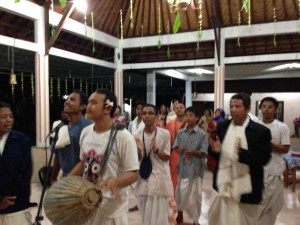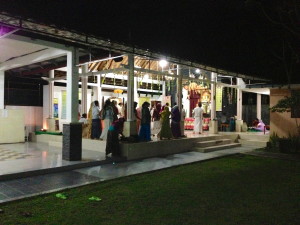Thursday, August 8th, 2013
→ The Walking Monk
Burnaby, British Columbia
I had begun and ended the day with chanting, walking by Riverside, established in 1861. The river being referred to is the Fraser, a major water artery in the lower mainland Vancouver.
Re-visiting the same route a second time felt like the day looped. I ended where I started. And that is pretty much how life is. It's cyclic. Such are the movements of the sun. The moon. The seasons go that way as well.
Our tiny spark of life, our very self, meets birth and death repeatedly until we make a change within. It's a circle game and then we make it linear. Apparently we will connect again with a world of circles.
The Sastras, ancient texts, reveal that we will be walking in a world free of inebriates.The walk, which will be under the shelter of either a fresh sun or a full moon, will have kick to it. It may be a skip, most definitely a dance.
I'm reminded that the current world in which we live in is a perverted reflection of the spiritual world. Our guru used to say this. We can ask ourself, "How can I get out of the perversities of life?" The answer would have some content to do with how you walk your way in this world. It would be good to take the steady march of dharma, of principles, while enjoying the stroll at the same time.
Out of a sense of duty, I found myself dealing with a number of practical issues involving the community. Some of the matter were quite draining but I pulled through and came to terms with sticking to duty. I felt some comfort in that resolve as well as some reciprocation from the Lord in the Heart.
I will try again, and again and try to loop it.
8 KM










 84 pics: Preaching and chanting on a Russian boat with Bhakti Vijnana Goswami, August 3, 2013
84 pics: Preaching and chanting on a Russian boat with Bhakti Vijnana Goswami, August 3, 2013  15 pics: Distribution of BBT Books in the United States of America
15 pics: Distribution of BBT Books in the United States of America  Cameron, ever since he was just a toddler, talks about another family he used to live with. He knows the names of his previous family, where they lived, and can even describe the house and the landscape of his previous home on the island of Barra, some 200 miles away.
Cameron, ever since he was just a toddler, talks about another family he used to live with. He knows the names of his previous family, where they lived, and can even describe the house and the landscape of his previous home on the island of Barra, some 200 miles away.  In the Bhagavad-gita Krishna lists six qualities -- pride, arrogance, conceit, anger, harshness and ignorance -- which mark the demoniac nature."
In the Bhagavad-gita Krishna lists six qualities -- pride, arrogance, conceit, anger, harshness and ignorance -- which mark the demoniac nature."  121 pics: Los Angeles Ratha Yatra 2013
121 pics: Los Angeles Ratha Yatra 2013  57 pics: Iskcon Hare Krishna Land Guyana
57 pics: Iskcon Hare Krishna Land Guyana 

 The devotees of Ramana Reti have done this nice site and facebook group and may be it coud be helpful to do for our other large Iskcon communities too
The devotees of Ramana Reti have done this nice site and facebook group and may be it coud be helpful to do for our other large Iskcon communities too 



 In the ISKCON Krishna-Balaram Temple at Vrindavan, the sanctum sanctorum of the Deities are beautifully decorated with green bush leaves and blossoming flowers for Them to feel pleasure-roam in the lush green forests of Vrindavan
In the ISKCON Krishna-Balaram Temple at Vrindavan, the sanctum sanctorum of the Deities are beautifully decorated with green bush leaves and blossoming flowers for Them to feel pleasure-roam in the lush green forests of Vrindavan 